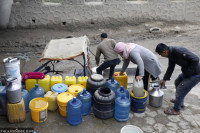Money
With final tests underway, Nepal-India cross-border oil pipeline nears operation
The petroleum pipeline, the first cross-border pipeline in South Asia, will come online on August 15..jpg&w=900&height=601)
Prahlad Rijal
More than two decades since work began, the Nepal-India cross-border petroleum pipeline is finally ready for operation, with authorities carrying out final functional tests on the 70 km structure. The structure is South Asia’s first cross-border pipeline.
According to the Nepal Oil Corporation, 65o kilolitres of water and subsequently, 3,100 kilolitres of diesel were released by India on Thursday, in the final test phase of the pipeline before its official inauguration.
“Officials at the Amlekhgunj depot are carrying out leakage tests and testing the integrity of the structure itself,” said Birendra Goit, spokesperson of the Nepal Oil Corporation. “If everything goes well, the pipeline will come into full operation on August 15.”
According to Goit, though the tests were supposed to be completed on Friday, they have yet to receive test results from officials at the depot.
The Nepal Oil Corporation hopes to save Rs 2 billion annually in freight charges and eliminate the vagaries of transportation via tanker trucks at Birgunj border point, once the cross-border pipeline comes online. It currently takes at least 14 hours to ferry gasoline from Patna to Amlekhgunj.
The project, first proposed by India in 1995, was officially agreed upon by Nepal in August 2015 after then Indian Minister for Petroleum and Natural Gas Dharmendra Pradhan and then Commerce and Supplies Minister Sunil Bahadur Thapa signed a construction pact to get the pipeline project rolling.
A few months after the agreement, the project hit a snag, owing to protests in the southern plains and the subsequent economic blockade by India.
According to the Nepal Oil Corporation, construction of the pipeline resumed in December 2017 after a two-year hiatus, with the Indian Oil Corporation laying foundations for the structure in Motihari, India.
Soon after construction began, Nepali and Indian authorities held a number of bilateral talks to expedite the construction of the Nepal portion of the import infrastructure, which runs around 38 kilometres underground through the under-construction Birgunj-Pathlaiya trade route and the Parsa National Park in Nepal.
The total project cost stands at INR 3.5 billion, out of which INR 750 million is borne by the Nepal Oil Corporation and the remaining portion is covered through Indian grants.
In lieu of future gasoline imports, the state-owned utility has also built storage tanks with a capacity to hold 16,000 kilolitres of petrol and diesel at the Amlekhgunj depot.
Out of the four planned tanks, two containers with a capacity to hold and release 4,100 kilolitres of gasoline and one 3,900 kilolitre container have been built so far.




 8.12°C Kathmandu
8.12°C Kathmandu















